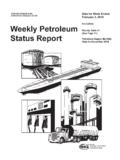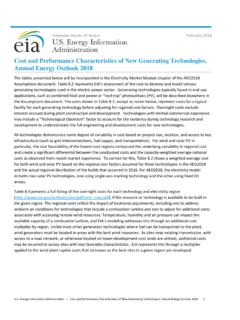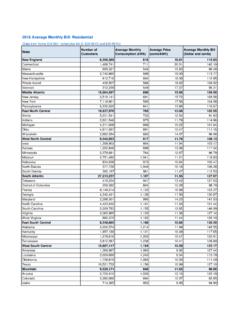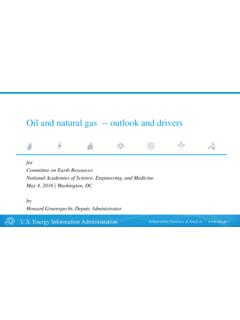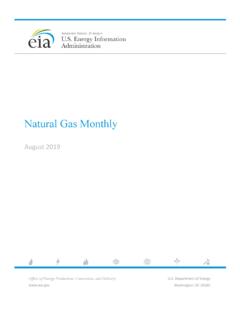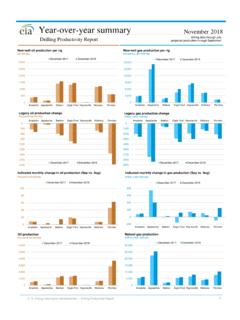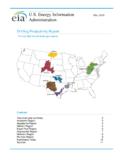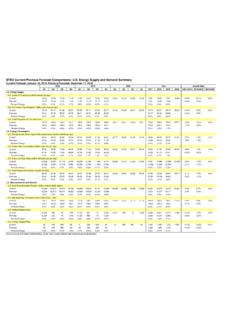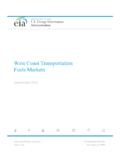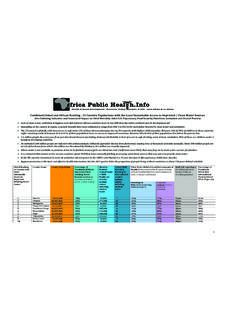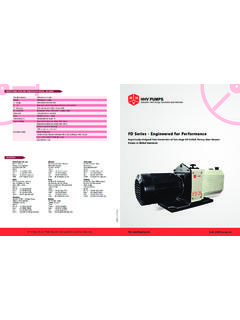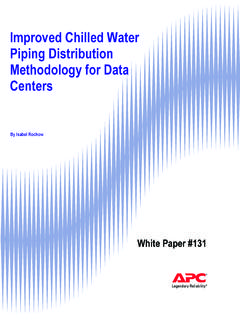Transcription of Trends in U.S. Oil and Natural Gas Upstream Costs
1 Trends in Oil and Natural Gas Upstream Costs March 2016 Independent Statistics & Analysis Department of Energy Washington, DC 20585 Energy Information Administration | Trends in Oil and Natural Gas Upstream Costs i This report was prepared by the Energy Information Administration (EIA), the statistical and analytical agency within the Department of Energy. By law, EIA s data, analyses, and forecasts are independent of approval by any other officer or employee of the United States Government. The views in this report therefore should not be construed as representing those of the Department of Energy or other federal agencies. March 2016 Energy Information Administration | Trends in Oil and Natural Gas Upstream Costs ii Contents Summary .. 1 Onshore Costs .. 2 Offshore Costs .. 5 Approach .. 6 Appendix IHS Oil and Gas Upstream cost Study (Commission by EIA) .. 7 I. IHS 3 II.
2 Summary of Results and Conclusions Onshore IHS 7 III. Deep Water Gulf of IHS 23 IV. Methodology and Technical IHS 29 V. Bakken Play Level IHS 35 VI. Eagle Ford Play Level IHS 53 VII. Marcellus Play Level IHS 69 VIII. Permian Play Level IHS 85 IX. Deepwater Gulf of IHS 103 Figures Figure 1. Regional shale development has driven increases in crude oil and Natural gas production . 2 Figure 2 Percentage breakdown of cost shares for onshore oil and Natural gas drilling and completion .. 3 Figure 3. Average well drilling and completion Costs for the 5 onshore plays studied follow similar trajectories .. 4 Figure 4. cost per vertical depth and horizontal length .. 5 March 2016 Energy Information Administration | Trends in Oil and Natural Gas Upstream Costs 1 Summary The profitability of oil and Natural gas development activity depends on both the prices realized by producers and the cost and productivity of newly developed wells.
3 Prices, Costs , and new well productivity have all experienced significant changes over the past decade. Price developments are readily observable in markets for oil and Natural gas, while Trends in well productivity are tracked by many sources, including EIA s Drilling Productivity Report which focuses on well productivity in key shale gas and tight oil plays. Regarding well development Costs , there is a general understanding that they are sensitive to increased efficiency in drilling and completion, which tends to lower Costs , shifts towards longer wells with more complex completions, which tends to increase them, and prices for oil and Natural gas, which affect markets for drilling and completion services through their effect on drilling activity. However, overall Trends in well development Costs are generally less transparent than price and productivity Trends . Given the role of present and future cost Trends to determining future trajectories of oil and Natural gas production under a range of possible future price scenarios, it is clearly important to develop a deeper understanding of cost drivers and Trends .
4 To increase the availability of such cost information, the Energy Information Administration (EIA) commissioned IHS Global Inc. (IHS) to perform a study of Upstream drilling and production Costs . The IHS report assesses capital and operating Costs associated with drilling, completing, and operating wells and facilities. The report focuses on five onshore regions, including the Bakken, Eagle Ford, and Marcellus plays, two plays (Midland and Delaware) within the Permian basin1, as well as the offshore federal Gulf of Mexico (GOM). The period studied runs from 2006 through 2015, with forecasts to 2018. Among the report s key findings are that average well drilling and completion Costs in five onshore areas evaluated in 2015 were between 25% and 30% below their level in 2012, when Costs per well were at their highest point over the past decade. Based on expectations of continuing oversupply of global oil in 2016, the IHS report foresees a continued downward trajectory in Costs as drilling activity declines.
5 For example, the IHS report expects rig rates to fall by 5% to 10% in 2016 with increases of 5% in 2017 and 2018. The IHS report also expects additional efficiencies in drilling rates, lateral lengths, proppant use, multi-well pads, and number of stages that will further drive down Costs measured in terms of dollars per barrel of oil-equivalent ($/boe) by 7% to 22% over this period. EIA is already using the observations developed in the IHS report as a guide to potential changes in near-term Costs as exploration and production companies deal with a challenging price environment. 1 The Bakken is primarily located in North Dakota, while the Marcellus is primarily located in Pennsylvania. The Eagle Ford and the two Permian plays (Midland and Delaware) are located in Texas. March 2016 Energy Information Administration | Trends in Oil and Natural Gas Upstream Costs 2 Onshore Costs Costs in domestic shale gas and tight oil plays were a key focus of EIA s interest given that development of those resources drove the major surge in crude oil and Natural gas production in the United States over the past decade, as shown in Figure 1.
6 The IHS report documents the Upstream Costs associated with this growth, including increases associated with the demand for higher drilling activity during expansion and decreases during the recent contraction of drilling activity. Figure 1. Regional shale development has driven increases in crude oil and Natural gas production Crude oil production Marketed Natural gas production million barrels per day billion cubic feet per day Source: Energy Information Administration Drilling Productivity Report regions, Petroleum Supply Monthly, Natural Gas Monthly Note: Shale gas estimates are derived from state administrative data collected by DrillingInfo Inc. and represent the Energy Information Administration s shale gas estimates, but are not survey data. The IHS report considers the Costs of onshore oil and Natural gas wells using the following cost categories: land acquisition; capitalized drilling, completion, and facilities Costs ; lease operating expenses; and gathering processing and transport Costs .
7 Total capital Costs per well in the onshore regions considered in the study from $ million to $ million, including average completion Costs that generally fell in the range of $ million to $ million per well. However, there is considerable cost variability between individual wells. Figure 2 focuses on five key cost categories that together account for more than three quarters of the total Costs for drilling and completing typical onshore Rig and drilling fluids Costs make up 15% of total Costs , and include expenses incurred in overall drilling activity, driven by larger market conditions and the time required to drill the total well depth. Casing and cement Costs total 11% of total 2 Typical onshore wells are multi-stage, hydraulically fractured, and drilled horizontally. The Costs identified relate, in part, to the application of those technologies. - 2 4 6 8 10 Rest of Gulf of MexicoPermian regionEagle Ford regionBakken region - 10 20 30 40 50 60 70 80 90 Rest of of shaleMarcellus regionMarch 2016 Energy Information Administration | Trends in Oil and Natural Gas Upstream Costs 3 Costs , and relate to casing design required by local well conditions and the cost of materials.
8 Frac Pumps, Equipment Costs make up 24% of total Costs , including the Costs of equipment and horsepower required for the specific treatment. Proppant Costs make up an average of 14% of total Costs and include the amount and rates for the particular type of material introduced as proppant in the well. Completion fluids, flow back Costs make up 12% of total Costs , and include sourcing and disposal of the water and other materials used in hydraulic fracturing and other treatments that are dependent on geology and play location as well as available sources. Figure 2 Percentage breakdown of cost shares for onshore oil and Natural gas drilling and completion Source: IHS Oil and Gas Upstream cost Study commissioned by EIA Over time, these Costs have changed. For example, drilling and completion cost indices shown in Figure 3 during the period when drilling and drilling services industries were ramping up capacity from 2006 to 2012 demonstrate the effect of rapid growth in drilling activity.
9 Since then, reduced activity as well as improved drilling efficiency and tools used have reduced overall well Costs . Changes in cost rates and well parameters have affected plays differently in 2015, with recent savings ranging from 7% to 22% relative to 2014 Costs . 15%11%24%14%12%23%Rig and drilling fluidCasing and cementFrac Pumps, EquipmentProppantCompletion fluids, flow backOtherMarch 2016 Energy Information Administration | Trends in Oil and Natural Gas Upstream Costs 4 Figure 3. Average well drilling and completion Costs for the 5 onshore plays studied follow similar trajectories cost by year for 2014 well parameters $ million per well Note: Midland and Delaware are two plays within the Permian basin, located in Texas and New Mexico Source: IHS Oil and Gas Upstream cost Study commissioned by EIA The onshore oil and Natural gas industry continues to evolve, developing best practices and improving well designs.
10 This evolution resulted in reduced drilling and completion times, lower total well Costs , and increased well performance. Drilling technology improvements include longer laterals, improved geo-steering, increased drilling rates, minimal casing and liner, multi-pad drilling, and improved efficiency in surface operations. Completion technology improvements include increased proppant volumes, number and position of fracturing stages, shift to hybrid fluid systems, faster fracturing operations, less premium proppant, and optimization of spacing and stacking. Although well Costs are trending higher, collectively, these improvements have lowered the unit cost of production in $/boe. The cost variations across the studied areas arise primarily from differences in geology, well depth, and water disposal options. For example, Bakken wells are the most costly because of long well lengths and use of higher- cost manufactured and resin coated proppants.
